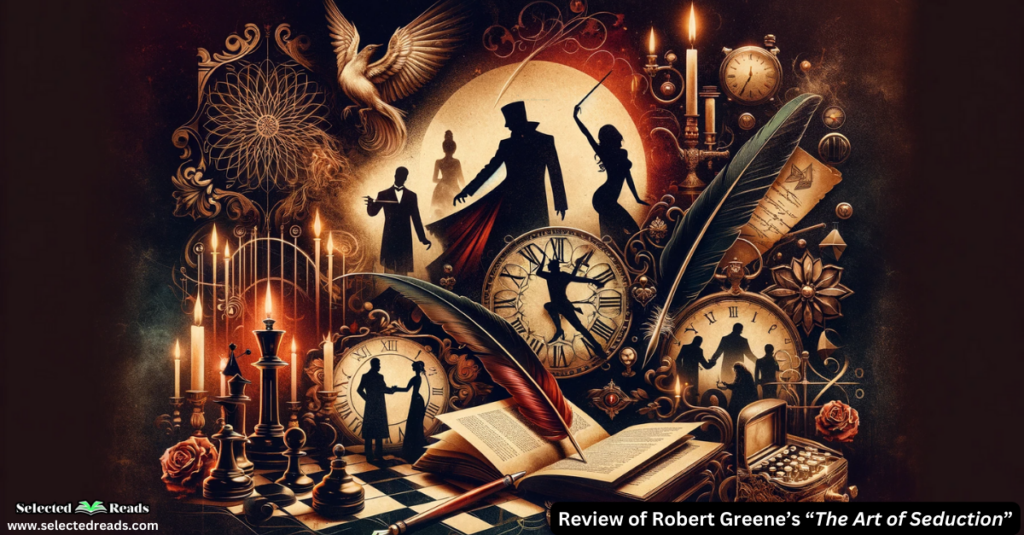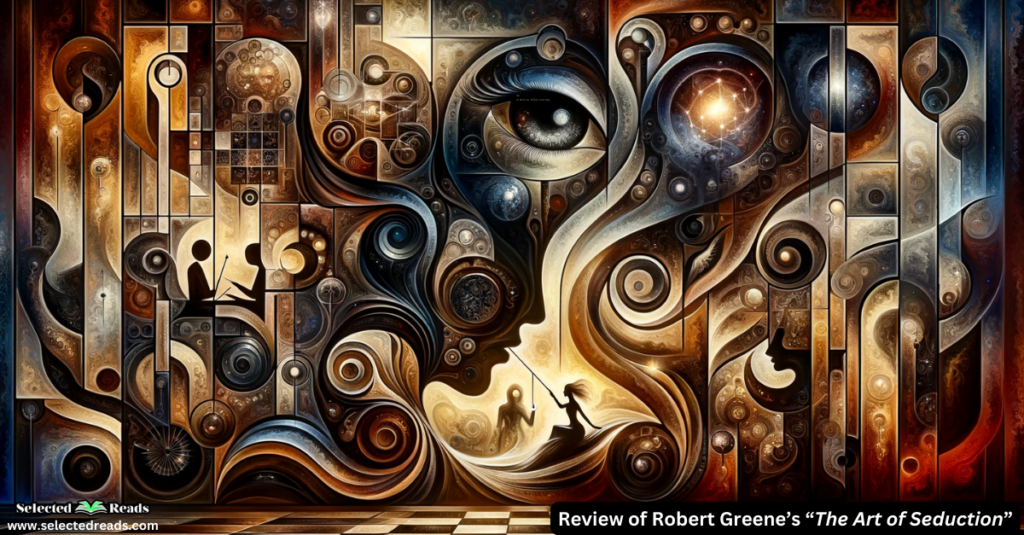In today’s post, we’re delving into the mesmerizing world of Robert Greene’s “The Art of Seduction.” This book, known for its insightful analysis and controversial themes, guides readers through the intricate maze of seduction as a form of power.
First, I’ll provide a summary of the book, offering a glimpse into its core concepts and the overarching themes Greene presents. Next, we’ll dissect Greene’s fascinating categorization of seducers. He identifies nine distinct types, each with unique traits and methods for captivating their targets.
We’ll also look at the various seduction strategies Greene discusses and for those who love a good discussion, I’ve prepared a set of thought-provoking book club questions. These questions are designed to spark deep conversations and insights, whether you’re chatting with fellow educators, book lovers, or anyone interested in the psychological and social dynamics of influence.
And, for those who are intrigued by Greene’s eloquent words, I invite you to check out my other post titled The Art of Seduction Quotes where I’ve featured a selection of quotes from the book. It’s a treasure trove of Greene’s wisdom and rhetoric, perfect for those who appreciate the art of language in conveying complex ideas.
The Art of Seduction Summary
“The Art of Seduction” by Robert Greene, published in 2001, is a fascinating exploration into the nuanced world of seduction. Greene, already known for his work on power dynamics in “The 48 Laws of Power,” delves deep into seduction not just as a skill but as an art form.
A lot of people mistakenly think that the book is merely about romantic seduction when in fact the Art of Seduction is much more than that. It is about the broader concept of seduction as a form of ultimate power and influence, a tool that has been instrumental in shaping historical events and personal interactions.
At the heart of Greene’s thesis is the idea that seduction is an indirect form of power. Unlike overt power plays, seduction is subtle, relying on allure, persuasion, and psychological strategies. Greene argues that when executed with finesse, seduction can topple empires, influence elections, and captivate influential minds.
Photo: Amazon
The book outlines twenty-four tactics and strategies integral to mastering the art of seduction. These include the likes of “Poeticizing Your Presence,” which emphasizes the importance of creating an intriguing and magnetic persona, and “Keep them in Suspense – What Comes Next,” which focuses on creating an aura of mystery and unpredictability. Another compelling strategy is “Master the Art of the Bold Move,” which encourages decisive, confident actions to captivate the target’s attention.
Greene’s work is underpinned by a rich tapestry of historical anecdotes and examples, drawing from the lives of figures like Cleopatra and Josephine Bonaparte to modern celebrities. This historical grounding gives the book a depth that transcends a simple how-to guide; it’s a delve into the psychology and sociology behind seduction.
In terms of its reception, “The Art of Seduction” has enjoyed significant popularity, reflected in its high ratings and widespread readership. It’s seen as an essential read, akin to Greene’s “The 48 Laws of Power,” for anyone interested in understanding the dynamics of influence and psychological manipulation.
In essence, “The Art of Seduction” is a compelling read, offering deep insights into the subtle art of influence and power. While its principles might not be universally accepted or ethically aligned with everyone’s values, it provides a unique perspective on human interactions and the nuanced ways in which people can be influenced.
What Are The 9 Types of Seducers?
Robert Greene, in “The Art of Seduction,” outlines nine distinct types of seducers, each characterized by their unique methods and appeal (pages 5 to 130). Here’s a summary of each type:
- The Siren: The Siren is the ultimate fantasy figure for men, offering an escape from the constraints of their lives. In the Siren’s presence, heightened and sexually charged, men feel transported to a world of pure pleasure. The Siren embodies control and allure, capitalizing on the male libido by personifying their deepest fantasies.
- The Rake: Appealing to women who crave attention and desire, the Rake is the epitome of intense, albeit fleeting, desire. He is characterized by his willingness to go to great lengths for a woman, regardless of his own disloyalty and amoral tendencies. This type stirs a woman’s repressed longings through a dangerous mix of pleasure and risk.
- The Ideal Lover: The Ideal Lover thrives on people’s broken dreams and unfulfilled youth fantasies, offering the romance, adventure, or spiritual communion they long for. They are artists in creating the illusion required by their target, capitalizing on the power of seduction in a world marred by disenchantment.
- The Dandy: The Dandy represents fluidity and freedom, defying conventional roles and expectations. By playing with masculinity and femininity and crafting a unique physical image, the Dandy attracts those who yearn for a similar freedom, stirring repressed desires through their ambiguous and alluring presence.
- The Natural: Representing the qualities of childhood—spontaneity, sincerity, unpretentiousness—the Natural makes people feel at ease and playful, reminiscent of a ‘golden paradise’. Their presence neutralizes defenses and spreads infectious joy.
- The Coquette: Masters of the art of delayed satisfaction, Coquettes excel in a game of hope and frustration. They tantalize with the promise of reward (pleasure, happiness, fame, power) that remains just out of reach, keeping their targets in a state of persistent pursuit.
- The Charmer: Charm is about seduction sans sexuality. Charmers manipulate by creating a comfortable and pleasing atmosphere, focusing not on themselves but on their target. They connect with your spirit, empathize with your pain, and adapt to your moods, enhancing your self-esteem and vanity.
- The Charismatic: Charismatics possess a magnetic presence rooted in self-confidence, sexual energy, and a sense of purpose. This inner quality radiates outward, making them seem extraordinary. They enhance their charisma with intense gaze, passionate speech, and an air of mystery.
- The Star: The Star stands out through their distinctive style, feeding on people’s desire to escape the harshness of daily life into fantasies. They maintain a dreamlike, ethereal distance, allowing others to project their fantasies onto them, captivating the unconscious with their elusive presence.
Greene argues that by understanding the different types of seductive characters, individuals can develop their own seductive skills and strategies. However, he also warns that seduction can be dangerous if used irresponsibly, and that individuals should use their powers of seduction ethically and with consideration for others.
Seduction Strategies
Some of the main seduction strategies outlined in the Robert Green’s Art of Seduction include:
- Create an air of mystery – By keeping some aspects of yourself hidden, you can create a sense of intrigue and allure that draws others in.
- Use words to your advantage – By using persuasive language and appealing to the emotions of the target, you can create a powerful connection and increase your chances of seduction.
- Play hard to get – By maintaining a distance and creating the illusion of being unattainable, you can increase your attractiveness and create a sense of desire in the target.
- Create a need – By highlighting the target’s needs and desires and offering to fulfill them, you can create a powerful emotional connection and increase your chances of success.
- Use physical touch – By using physical touch in a subtle and seductive way, you can increase intimacy and create a powerful emotional connection with the target.
- Use the power of suggestion – By using suggestive language and imagery, you can plant ideas in the target’s mind and create a sense of desire and longing.
Final thoughts
Greene presents seduction as a multifaceted form of power, relevant in various aspects of life, including social dynamics, personal relationships, and even professional environments. His categorization of seducers into nine distinct types provides a fascinating framework for understanding different methods of influence and attraction.
The seduction strategies outlined in the book, while controversial to some, offer insights into the psychological underpinnings of human behavior and interaction. These strategies underscore the importance of adaptability, perception, and the art of persuasion, which are undoubtedly relevant in fields as diverse as education, technology, and beyond.





